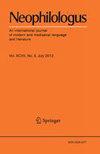Did Old English Verse Have a “Morphological” Metre?
IF 0.2
3区 文学
0 LANGUAGE & LINGUISTICS
引用次数: 0
Abstract
Abstract The revision of the four-position theory of Old English metre by Yakovlev (2008) has had a considerable impact, both for its simplification of Sievers’ (1893) metrical principles, and for its supposed shift to a “morphological” rather than an “accentual” metrical type. I contextualize Yakovlev’s important contribution to metrical theory, highlighting that his main innovations are to eliminate the principle that every verse should have two lifts, and to collapse the metrical notions of “lift” and of “half-lift” into a single type of unit, the “strong position”. These major and thoughtful innovations are unconnected to the supposed “morphological” aspect of Yakovlev’s system, which consists of arbitrary and unmotivated stipulations of certain classes of syllables as inherently strong or weak. Calling the metre “morphological” on this basis is at best misleading, placing too much emphasis on a marginal component of the system. Moreover, the definitions of strong and weak positions are better explained with reference to linguistic stress: elements bearing some degree of stress (primary or secondary) are strong, while those bearing no stress are weak. Such a reframing leads to a slight revision of Yakovlev’s theory to incorporate the “rule of the coda” (Fulk, 1992). The result is a version of Yakovlev’s theory which is both theoretically simpler and more descriptively adequate, but in which the label “morphological” lacks even the limited and inapt validity of the original version. This reintroduction of stress into the system does not, however, make the theory “accentual”, and it remains better characterized as an “alliterative-syllabic” view of the metre (Cable, 1991).古英语诗歌有“形态”格律吗?
Yakovlev(2008)对古英语韵律四位置理论的修订产生了相当大的影响,既因为它简化了Sievers(1893)的韵律原则,也因为它被认为是“形态”而不是“重音”的韵律类型。我将雅科夫列夫对格律理论的重要贡献置于语境中,强调他的主要创新是消除了每首诗应该有两个提升的原则,并将“提升”和“半提升”的格律概念分解为单一类型的单位,即“强位”。这些重大而深思熟虑的创新与雅科夫列夫系统中所谓的“形态学”方面无关,雅科夫列夫系统由某些音节的固有强弱类别的任意和无动机规定组成。在此基础上称节拍为“形态”充其量是误导,过分强调系统的边缘组成部分。此外,强弱位置的定义可以更好地参考语言重音来解释:带有一定程度重音(主要或次要)的元素是强的,而没有重音的元素是弱的。这样的重构导致对雅科夫列夫的理论进行了轻微的修改,以纳入“尾声规则”(Fulk, 1992)。结果是Yakovlev理论的一个版本,它在理论上更简单,描述性更充分,但其中的“形态”标签甚至缺乏原始版本的有限和不恰当的有效性。然而,将重音重新引入到系统中并没有使该理论成为“重音”理论,它仍然被更好地描述为韵律的“头韵-音节”观点(Cable, 1991)。
本文章由计算机程序翻译,如有差异,请以英文原文为准。
求助全文
约1分钟内获得全文
求助全文
来源期刊

NEOPHILOLOGUS
Multiple-
CiteScore
0.50
自引率
0.00%
发文量
29
期刊介绍:
Neophilologus is an international peer-reviewed journal devoted to the study of modern and medieval language and literature, including literary theory, comparative literature, philology and textual criticism. The languages of publication are English, French, German and Spanish.
 求助内容:
求助内容: 应助结果提醒方式:
应助结果提醒方式:


